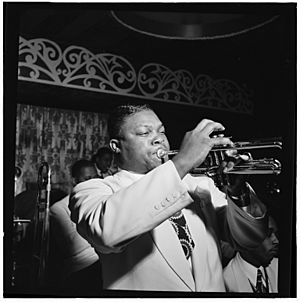Cat Anderson facts for kids
Quick facts for kids
Cat Anderson
|
|
|---|---|

Anderson in New York, c. 1947
|
|
| Background information | |
| Birth name | William Alonzo Anderson |
| Also known as | Cat Anderson |
| Born | September 12, 1916 Greenville, South Carolina, U.S. |
| Died | April 29, 1981 (aged 64) Norwalk, California |
| Genres | Jazz |
| Occupation(s) | Musician |
| Instruments | Trumpet |
| Years active | 1930s–1970s |
| Labels | |
| Associated acts |
|
William Alonzo "Cat" Anderson (born September 12, 1916 – died April 29, 1981) was an American jazz trumpeter. He was famous for playing with Duke Ellington's orchestra for many years. He was also known for his amazing ability to play very high notes on the trumpet.
Contents
Biography
Early Life and Nickname
Cat Anderson was born in Greenville, South Carolina. He lost both his parents when he was only four years old. He then went to live at the Jenkins Orphanage in Charleston. This is where he started learning to play the trumpet. His friends at the orphanage gave him the nickname "Cat." He used this name for the rest of his life.
Starting His Music Career
Anderson began his music journey by touring and making his first recordings. He played with a small group from the orphanage called the Carolina Cotton Pickers. After leaving this group, he played with several other bands. These included Hartley Toots, Claude Hopkins' big band, and Doc Wheeler's Sunset Orchestra. He also played with Lucky Millinder, the Erskine Hawkins Orchestra, and Lionel Hampton. With Lionel Hampton, he recorded a famous song called "Flying Home No. 2."
Joining Duke Ellington
In 1944, Anderson's career really took off. He joined Duke Ellington's orchestra in Philadelphia. He quickly became a very important part of Ellington's unique sound. Cat Anderson was a very skilled musician. He could play many different jazz styles.
His Special Trumpet Skills
Anderson was most famous for playing extremely high notes on the trumpet. This is called the "altissimo" range. He had a powerful sound in all notes, but he could play incredibly high. He could even play a "triple C," which is one of the highest notes on a piano. He played these high-note solos without a microphone. Other musicians usually needed microphones for their solos.
Wynton Marsalis, another famous trumpeter, called him "one of the best" high-note trumpeters. But Cat Anderson was more than just a high-note player. He was also great at using special techniques like "half valve" and "plunger mute" playing. Another musician, Dan Morgenstern, said he was the band's "Number One utility trumpeter." This meant he could play any trumpet part needed.
Years with Ellington and Beyond
Cat Anderson played with Duke Ellington's band for many years. He was with them from 1944 to 1947, then from 1950 to 1959, and again from 1961 to 1971. During his breaks from Ellington, he led his own big band. Besides playing the trumpet, he was also a talented arranger and composer. He performed his own songs like "El Gato" and "Bluejean Beguine" with Ellington. He also recorded his own music, such as his 1959 album "Cat on a Hot Tin Horn."
After 1971, Anderson moved to the Los Angeles area. He continued to play music in recording studios. He also performed with local bands, including those led by Louie Bellson and Bill Berry. He also toured in Europe. Cat Anderson passed away in 1981 after a serious illness.
Music Recordings
Cat Anderson released several albums as a band leader. He also played on many recordings as a sideman with other famous jazz artists.
Albums by Cat Anderson
- Cat Anderson Plays at 4 AM (1958)
- Cat on a Hot Tin Horn (1958)
- Cat Speaks (1977)
Playing with Other Artists
Cat Anderson played trumpet on many albums for other jazz legends. He recorded with:
- Gene Ammons
- Louie Bellson
- Duke Ellington (on many, many albums!)
- Ella Fitzgerald
- Lionel Hampton
- Johnny Hodges
- Quincy Jones
- And many more!
Images for kids
-
From left: Louie Bellson, Cat Anderson, Clark Terry at the Palomar Supper Club, April 19, 1952, with the Duke Ellington Orchestra; Photo courtesy of the Fraser MacPherson estate
See also
 In Spanish: Cat Anderson para niños
In Spanish: Cat Anderson para niños


